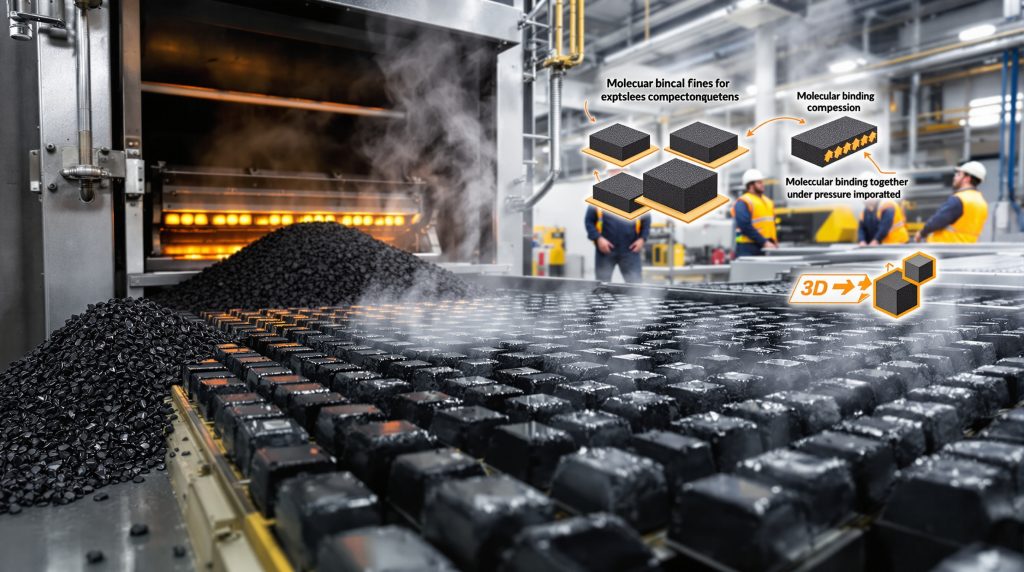What is Binderless Coal Briquetting Technology?
Binderless coal briquetting (BCB) technology transforms previously discarded coal fines into valuable fuel products without using chemical additives. This innovative approach relies on the inherent binding properties of coal particles when subjected to specific pressure and temperature conditions, creating stable briquettes with improved handling characteristics and combustion properties.
Unlike traditional briquetting methods that require external binding agents like starch, molasses, or tar, BCB technology leverages the natural cohesive properties within certain coal types to form solid, durable briquettes through mechanical compression alone. This distinction makes the process more cost-effective and environmentally sound while maintaining the original chemical composition of the coal.
How Does the Binderless Coal Briquetting Process Work?
Feed Material Preparation
The BCB process begins with the recovery of coal fines—typically particles smaller than 200 microns—that would otherwise be discarded as waste. These ultrafine particles, often referred to as filter cake, contain valuable carbon but are traditionally difficult to handle and process due to their high moisture content and dusty nature.
The feed material can come from various sources:
- Current coal processing waste streams
- Historical coal discard dumps
- Fine coal slurries from washing plants
- Ultrafine coal particles from filtration systems
Before briquetting, the feed material undergoes preliminary processing to achieve optimal particle size distribution and moisture content. This may involve screening, classification, and sometimes beneficiation to improve the quality of the final product.
Dewatering and Drying
One of the critical steps in the BCB process is moisture management. The technology can accept feed materials with moisture contents up to 26%, but controlling moisture is essential for successful briquetting.
The wet coal fines are typically processed through:
- A dewatering stage to remove excess surface moisture
- A hot gas drying system that reduces internal moisture to optimal levels
- Temperature-controlled processing that preserves the coal's natural binding properties
This moisture reduction serves two purposes: it improves the energy value of the final product and creates conditions favorable for particle bonding during compression.
Compression and Briquette Formation
The heart of the BCB technology lies in the compression phase, where the prepared coal fines are subjected to high pressure in specialized equipment. During compression:
- Coal particles undergo plastic deformation
- Natural clay minerals within the coal act as binding agents
- Internal moisture facilitates particle adhesion
- High pressure forces particles into close contact, creating strong molecular bonds
The compression equipment typically consists of roller presses or piston-type briquetting machines that apply pressures sufficient to overcome the elastic limit of the coal particles, causing them to deform and interlock. The specific pressure requirements vary based on coal type, with some varieties requiring less pressure due to their higher natural binding capacity.
Cooling and Stabilization
After compression, the newly formed briquettes undergo cooling and stabilization to develop their final strength and durability. This phase allows:
- Internal moisture to redistribute
- Molecular bonds to strengthen
- Surface hardening to occur
- Thermal stabilization to prevent cracking
The cooling process is carefully controlled to prevent thermal shock that could compromise briquette integrity. Once cooled, the briquettes develop their full mechanical strength, making them suitable for handling, transport, and storage.
What Makes Coal Suitable for Binderless Briquetting?
Coal Rank and Composition
The rank of coal significantly influences its binding properties. Generally:
- Sub-bituminous coals often contain more natural binding compounds
- Bituminous coals with moderate vitrinite content show good binding potential
- Coals with higher clay mineral content provide additional binding mechanisms
- Coals with balanced maceral composition (vitrinite, inertinite, and liptinite) typically perform better
In South Africa's Witbank coalfield, the high vitrinite content and clay minerals in discard coal have proven particularly conducive to natural bonding in briquettes, according to testing conducted at River Energy's pilot plant in Johannesburg (Mining Weekly, 2025).
Particle Size Distribution
The distribution of particle sizes affects packing density and binding efficiency:
- A mix of fine and ultrafine particles creates optimal packing
- Particles predominantly under 200 microns provide sufficient surface area for binding
- A small percentage of larger particles (up to 1mm) can improve structural integrity
Recent tests at River Energy's pilot plant in South Africa beneficiation successfully processed material ranging from minus 200 microns to plus 53 microns after beneficiation, demonstrating the technology's ability to handle typical filter cake material that mines commonly discard (Mining Weekly, 2025).
Moisture Content
Moisture plays a dual role in binderless briquetting:
- Too much moisture interferes with particle bonding
- Too little moisture prevents adequate plasticity during compression
- Optimal moisture typically ranges from 8-12% depending on coal type
- Controlled drying to reach this range is often necessary
BCB technology has demonstrated the ability to process feed materials with up to 26% moisture content, though optimal results require careful moisture reduction. In tests conducted in South Africa, moisture was reduced by 77%, from 12.3% to below 3%, creating briquettes with significantly improved energy value (Mining Weekly, 2025).
Natural Binding Compounds
Certain compounds naturally present in coal enhance binding capacity:
- Clay minerals (kaolinite, illite) act as natural binders
- Humic acids in younger coals provide adhesive properties
- Residual bitumen in some coals offers thermoplastic binding
- Mineral matter composition influences bond strength
What Are the Quality Characteristics of Coal Briquettes?
Physical Properties
- Mechanical strength: Measured through drop-shatter tests, compression tests, and abrasion resistance
- Density: Typically 1.2-1.5 g/cm³, significantly higher than raw coal fines
- Size and shape uniformity: Consistent dimensions for improved handling and combustion
- Weather resistance: Ability to withstand exposure to environmental conditions without degradation
River Energy's testing protocols include dropping briquettes onto a steel plate from 1.8 meters height to simulate handling and transport conditions, with results showing excellent resistance to breakage (Mining Weekly, 2025).
Thermal Properties
- Calorific value: Often improved by 3-5% compared to the feed coal due to moisture reduction
- Combustion efficiency: More complete burning with reduced particulate emissions
- Ignition characteristics: Controlled ignition temperature and burning rate
- Ash content and composition: Dependent on the feed material quality
Laboratory tests of South African coal briquettes have demonstrated approximately 3% improvement in calorific value – from about 23 MJ/kg to 24 MJ/kg – directly attributable to moisture reduction and consistent particle packing (Mining Weekly, 2025).
Handling Characteristics
- Dust generation: Significantly reduced compared to loose coal fines
- Storage stability: Resistance to degradation during stockpiling
- Transport durability: Ability to withstand handling and shipping without excessive breakage
- Moisture reabsorption: Limited water uptake when exposed to humidity or precipitation
Four-week stockpile tests at River Energy's facility confirmed the long-term durability of binderless briquettes, with the proportion of fine material generated through degradation remaining below 15%, well within domestic and export coal specifications (Mining Weekly, 2025).
How Does BCB Technology Compare to Binder-Based Methods?
Cost Considerations
| Factor | Binderless Briquetting | Binder-Based Briquetting |
|---|---|---|
| Raw material costs | Lower (no binder purchase) | Higher (binder costs add 15-30%) |
| Equipment complexity | Moderate (pressure-focused) | Higher (mixing and curing) |
| Energy requirements | Moderate (drying and compression) | Higher (mixing, drying, curing) |
| Maintenance costs | Lower (fewer components) | Higher (more complex systems) |
| Production throughput | Generally higher | Limited by mixing/curing |
Environmental Impact
- Emissions: BCB typically produces fewer emissions during manufacturing due to the absence of chemical binders
- Waste generation: No binder packaging or handling waste
- Combustion byproducts: Cleaner burning without introduced chemicals
- Resource consumption: Reduced water and chemical usage
As highlighted by River Energy's coal geologist Maseda Mphaphuli, "What's important about our BCBs is that we are adding no binder. When we say binderless – we add no additives. Whatever we feed in, we get out" (Mining Weekly, 2025).
Product Quality
- Consistency: Binder-based methods may offer more consistent quality across varying coal types
- Strength: High-quality binders can produce stronger briquettes for some applications
- Weatherability: Some binders provide superior water resistance
- Specialized applications: Certain binders enable customization for specific end uses
What Are the Industrial Applications of BCB Technology?
Power Generation
- Fuel for coal-fired power plants
- Co-firing with biomass in renewable energy systems
- Backup fuel for intermittent renewable energy sources
- Distributed small-scale power generation
Industrial Heating
- Boiler fuel for process steam generation
- Industrial furnaces and kilns
- Cement production
- Ceramic manufacturing
Metallurgical Applications
- Pulverized coal injection in blast furnaces
- Reductant in various metallurgical processes
- Alternative to metallurgical coke in some applications
- Specialty carbon products
Residential and Commercial Heating
- Domestic heating in developing regions
- Commercial space heating
- District heating systems
- Specialized heating applications
River Energy has reported interest in their binderless coal briquetting technology from diverse sectors including mining, agricultural, chemical, and household applications, suggesting broad market potential for this technology (Mining Weekly, 2025).
What Are the Economic Benefits of BCB Technology?
Waste Stream Monetization
Converting previously discarded coal fines into marketable products creates new revenue streams. With global coal waste accumulation estimated in the billions of tons, the potential value recovery is substantial.
South Africa alone has accumulated over two billion tonnes of coal waste, with approximately 60 million tonnes added annually, including about 11 million tonnes of fine coal and slurry generated each year. This represents a significant untapped resource that BCB technology can help reclaim (Department of Mineral Resources and Energy, 2001, cited in Mining Weekly, 2025).
For example, a typical coal processing plant generating 100,000 tons of fine coal waste annually could potentially convert 70-80% of this material into saleable briquettes, representing millions in recovered value.
Operational Efficiency Improvements
BCB technology enhances overall coal processing efficiency by:
- Reducing material losses throughout the coal value chain
- Decreasing waste management and disposal costs
- Improving land utilization by reclaiming areas previously used for waste storage
- Minimizing environmental compliance costs related to waste management solutions
Product Value Enhancement
The briquetting process significantly increases the value of coal fines:
- Moisture reduction improves energy content per ton
- Consistent size and quality command premium pricing
- Reduced handling and transportation costs increase margins
- Access to markets that cannot accept raw coal fines
As observed at River Energy's South African pilot operation, "We managed to improve the trade value of the coal. It's also easier to transport due to the low moisture" (Mining Weekly, 2025).
Case Study: South African Implementation
South Africa's coal industry, with over two billion tons of accumulated coal waste and approximately 60 million tons added annually, represents a prime example of BCB technology's economic potential. Recent implementations have demonstrated:
- 77% reduction in moisture content (from 12.3% to below 3%)
- 3% improvement in calorific value (from 23 MJ/kg to 24 MJ/kg)
- Creation of marketable products from previously discarded material
- Significant interest from mining, agricultural, chemical, and household sectors
What Environmental Benefits Does BCB Technology Offer?
Land Reclamation
Coal waste dumps occupy vast land areas that could be reclaimed through BCB implementation:
- Reduction of existing waste piles
- Prevention of new waste accumulation
- Restoration of previously unusable land
- Mitigation of landscape degradation
With South Africa's coal waste potentially exceeding two billion tonnes and growing by 60 million tonnes annually (Mining Weekly, 2025), the land reclamation potential is substantial.
Water Quality Improvement
Coal fines often contribute to water pollution through:
- Acid mine drainage from waste dumps
- Suspended solids in water bodies
- Heavy metal leaching
- Sediment accumulation in waterways
BCB technology helps address these issues by removing fine coal particles from the environment and incorporating them into stable briquettes.
Air Quality Enhancement
The technology improves air quality through:
- Reduction of coal dust emissions during handling
- More complete combustion with fewer particulate emissions
- Decreased spontaneous combustion risk in coal storage
- Controlled burning characteristics
Resource Conservation
By maximizing the utilization of extracted resources, BCB technology supports conservation efforts:
- More complete utilization of mined coal
- Reduced need for additional mining to meet energy demands
- Extended life of existing coal reserves
- More efficient use of mining infrastructure
What Technical Challenges Must Be Overcome?
Coal Variability Management
Different coal sources exhibit varying binding properties, requiring:
- Adaptive processing parameters for different coal types
- Blending strategies to achieve consistent binding properties
- Real-time quality monitoring and adjustment
- Predictive models for binding behavior
The success of BCB technology in South Africa's Witbank coalfield is partly attributed to the specific coal characteristics found there. As noted by River Energy's coal geologist, "Since this is the Witbank coalfield, it is rich in vitrinite and also, since it's a discard coal, rich in clay minerals – but the clay minerals allow for the natural bonding in the briquettes themselves" (Mining Weekly, 2025).
Moisture Control Optimization
Achieving optimal moisture content remains challenging:
- Balancing drying energy costs against product quality
- Managing seasonal variations in feed material moisture
- Preventing over-drying that reduces binding capacity
- Maintaining moisture uniformity throughout the feed material
Scale-Up Considerations
Moving from pilot to commercial scale introduces challenges:
- Maintaining consistent pressure distribution in larger equipment
- Achieving uniform heating and cooling across larger volumes
- Managing increased throughput without quality degradation
- Optimizing energy efficiency at commercial scale
Equipment Durability
The high-pressure, abrasive environment of BCB operations demands:
- Wear-resistant materials for compression surfaces
- Precise alignment maintenance in mechanical systems
- Regular preventive maintenance protocols
- Innovative designs to extend component life
How Is BCB Technology Being Implemented Globally?
Australia
Australia has been at the forefront of BCB technology development, with:
- CSIRO's pioneering research and development efforts
- The Cessnock pilot plant demonstrating technical feasibility with a 150 tonnes per year capacity
- Commercial-scale implementations in coal-producing regions
- Ongoing research into advanced process optimization
The technology was originally developed by a consortium led by Australia's Commonwealth Scientific and Industrial Research Organisation (CSIRO), which established a 150 tonnes per year pilot plant in Cessnock, New South Wales (Mining Weekly, 2025).
South Africa
South Africa's substantial coal waste challenges have driven BCB adoption:
- River Energy's successful pilot implementation in Johannesburg's Denver industrial area
- Testing programs confirming applicability to local coal types
- Growing interest from multiple industrial sectors
- Plans for commercial-scale facilities
River Energy's pilot plant has successfully replicated the results achieved at CSIRO's Cessnock facility, demonstrating the technology's applicability to South African coal types. The company is currently exploring opportunities to scale up its facility and secure offtake agreements (Mining Weekly, 2025).
Indonesia
Indonesia has embraced BCB technology for its low-rank coal resources:
- A one-million-tonne-per-year commercial plant
- Focus on upgrading low-quality coals for export markets
- Integration with existing coal processing infrastructure
- Adaptation to high-moisture tropical coal conditions
The success of Indonesia's commercial-scale plant demonstrates the technology's viability at industrial production volumes (Mining Weekly, 2025).
China
China's coal industry has implemented BCB technology to address:
- Fine coal utilization in power generation
- Environmental compliance in coal processing
- Resource efficiency improvements
- Coal quality standardization
What Does the Future Hold for BCB Technology?
Process Optimization
Ongoing improvements focus on:
- Reduced energy consumption in drying and compression
- Increased throughput rates without quality compromise
- Advanced control systems for real-time parameter adjustment
- Integration with other coal beneficiation technologies
Product Customization
Future developments may enable:
- Tailored briquette properties for specific applications
- Blending with biomass or other materials for hybrid fuels
- Specialized shapes and sizes for particular combustion systems
- Enhanced properties through controlled processing conditions
Integration with Carbon Reduction Strategies
As industries navigate the energy transition, BCB technology could:
- Support cleaner coal utilization in developing economies
- Provide bridging technology during renewable energy scaling
- Enable more efficient carbon capture in coal utilization
- Contribute to circular economy approaches in the mining industry innovation
Expanded Applications
New applications continue to emerge:
- Specialized carbon products for advanced materials
- Chemical feedstock production
- Carbon sequestration approaches
- Novel energy storage concepts
River Energy is actively pursuing further testing, including compressive strength assessments, as part of their exploration of scale-up opportunities and potential market applications (Mining Weekly, 2025).
How to Implement BCB Technology: Key Considerations
Feed Material Assessment
- Conduct comprehensive testing of available coal fines
- Analyze binding potential through laboratory-scale trials
- Determine optimal moisture content and particle size distribution
- Assess variability in feed material properties
River Energy's implementation approach began with sending sample material to CSIRO's Cessnock facility in Australia for initial testing before building their own pilot plant in Johannesburg, demonstrating the importance of thorough material assessment (Mining Weekly, 2025).
Process Design Optimization
- Select appropriate equipment based on feed characteristics
- Design efficient drying and moisture control systems
- Optimize compression parameters for specific coal types
- Develop quality control protocols
Market Development Strategy
- Identify potential customers for briquetted products
- Determine product specifications to meet market requirements
- Develop pricing strategies that reflect enhanced value
- Establish distribution channels appropriate for the product
River Energy has already identified interest from mining, agricultural, chemical, and household sectors, indicating diverse market potential for binderless coal briquettes (Mining Weekly, 2025).
Economic Evaluation
- Calculate capital and operating costs for the specific implementation
- Determine payback period and return on investment
- Assess sensitivity to market price fluctuations
- Consider environmental compliance cost reductions
Conclusion: A Sustainable Approach to Coal Waste Management
Binderless coal briquetting technology represents a significant advancement in sustainable coal utilization. By transforming previously discarded coal fines into valuable fuel products without chemical additives, the technology addresses both economic and environmental challenges associated with coal processing.
The demonstrated success of BCB implementations in various regions confirms its technical viability and commercial potential. As the global energy landscape evolves, this technology offers a pathway to more complete resource utilization while reducing environmental impacts.
For coal-producing regions with substantial accumulated waste, BCB technology provides an opportunity to reclaim value from historical discards while preventing future waste accumulation. The resulting briquettes offer improved handling, transport, and combustion characteristics that make them attractive across multiple market sectors.
As research and implementation continue to advance, binderless coal briquetting is positioned to play an increasingly important role in responsible resource management within the evolving global energy mix, particularly as industries continue to focus on electrification and decarbonisation supported by data-driven operations.
Looking to Invest in Coal Technology Innovations?
Discovery Alert's proprietary Discovery IQ model provides instant notifications when ASX-listed companies make significant advancements in coal processing technologies like binderless coal briquetting. Explore why major mineral discoveries can lead to substantial returns by visiting Discovery Alert's dedicated discoveries page and position yourself ahead of the market.




